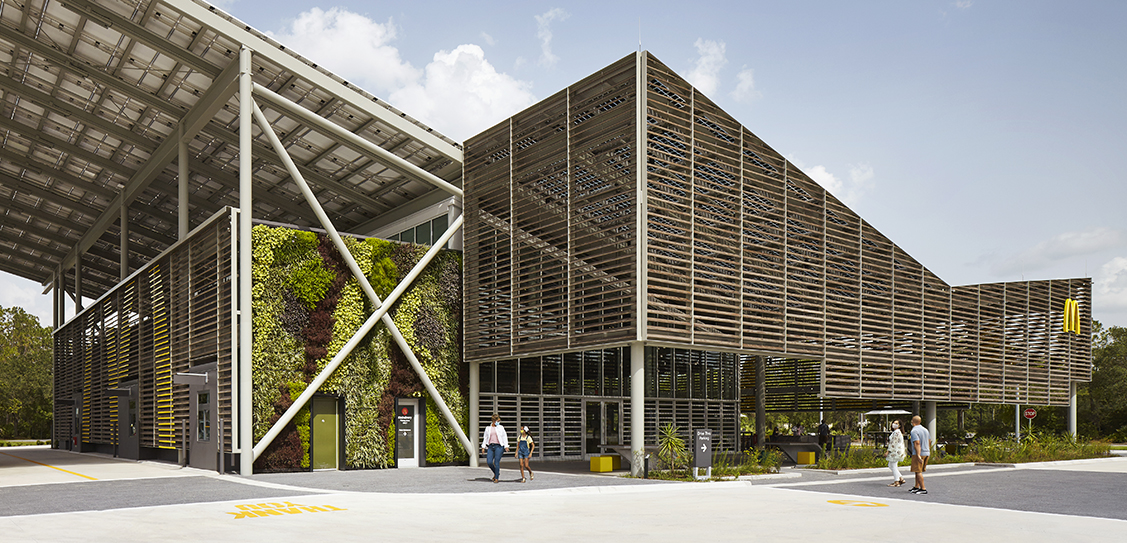Incorporating visible and impactful symbols of change, the restaurant uses architecture and technology to firmly place itself in the future.
Under a canopy clad in solar panels, the restaurant is a sustainable and healthy response to the Florida climate. Energy consumption is reduced by optimising building and kitchen systems. On site generation strategies include 18,727 sq ft of photovoltaic panels, 4,809 sq ft of glazing integrated photovoltaic panels (BiPV), and 25 off-the-grid parking lot lights produce more energy than the restaurant uses.
Taking advantage of the humid subtropical climate, the building is naturally ventilated roughly 65% of the year. Jalousie windows, operated by outdoor humidity and temperature sensors, close automatically when air conditioning is required. An outdoor “porch” features wood louvered walls and fans to create an extension of the indoor dining room.
A robust education strategy was a goal of the project. The architecture itself becomes a narrative tool in addition to interior wall graphics, interactive video content, and gaming unique to this location. The restaurant teaches visitors of all ages how to be more dedicated environmental stewards at a building, system, and individual scale.
As an energy intensive building typology and arguably an enabler of automobile culture, the McDonald’s Disney Flagship explores its role as a sustainable steward; revolutionising an industry to be more thoughtful, strategic, and impactful.
Ross Barney Architects took inspiration from McDonald’s “Scale for Good”. This initiative goes beyond the impact of buildings and utilises the United Nations Sustainable Development Goals to provide a holistic and ambitious impact at a global scale.
Located within the Walt Disney World Resort, this iconic McDonald’s has made a statement to visitors for more than two decades. The original Happy Meal inspired design by Venturi Scott Brown utilised a narrative storytelling that has inspired the 2020 remake. Instead of focusing on history, the new restaurant firmly places itself in the future.
Sited within the wetlands that comprise most of the Walt Disney World Resort property, the Flagship is a sensitive steward of its context. Set against the backdrop of lush greenery the building itself attempts to blend in with a natural material palette. Unique to its surroundings, the building seems to grow from the site; futuristic yet contextual. 38% of the 1.5 acre site is pervious, helping redirect rainfall from the storm sewer and back into the ecosystem.
Quick service, or fast food, restaurants are one of the highest median energy use market sectors tracked by Energy Star. With a 35% decrease in energy use, the new building has a predicted EUI of 283 kBtu/sf/yr. This consumption is then offset by on site renewable energy, making the Flagship a Net Positive Energy Building.
The design team took the final energy profile and explored options for on site power generation, which included solar, geothermal, and wind. Based on cost to generation ratios, solar was selected. Three types of panels were used; 1,066 standard photovoltaic panels, 4,809 sq ft of a glazing integrated system (photovoltaic sandwiched between glass) to shade outdoor seating, and 25 off-the-grid parking lot lights.
Taking advantage of the humid subtropical climate, the building is naturally ventilated 65% of the year. Jalousie windows, operated by outdoor humidity and temperature sensors, close automatically when air conditioning is required. An outdoor “porch” features wood louvered walls and fans to create an extension of the indoor dining room.
Early studies found that 65% of the year was considered comfortable in the shade based on temperature, humidity, and airflow. Responding to this data, the building re-introduces an indoor and outdoor relationship unique to Florida’s vernacular architecture. An extensive outdoor “porch” takes inspiration from lanais and features wood louvered walls, a BiPV skylight system, and fans to create a comfortable extension of the dining room.
The dining room facade features jalousie windows, another unique element to Florida’s vernacular architecture. Throughout the day, these windows open and close automatically to let in fresh air. Sensors track humidity and temperature, assuring that indoor environments are comfortable.
Adjacent to the porch is an outdoor activity area that features stationary bikes. While some might see this as a contradictory statement, these energy generating machines are part of the larger sustainability narrative. Through exercise, visitors can learn the direct impacts of human power by lighting up a graphic within the living wall or getting a little extra juice for their smartphone.
In a context dominated by the automobile, the design team focused on creating an oasis for the restaurant and its extensive outdoor seating. Surrounded primarily by Florida native plants, the site springs to life with colour and biodiversity. Nearly 1,800 sq ft of the facade features an irrigated green wall improving insulation value and cleaning the microclimate.
A robust education strategy was a goal of the project from the beginning. The architecture itself becomes a narrative tool in addition to interior graphics, interactive video content, and gaming unique to this location. The restaurant teaches visitors of all ages to be more dedicated environmental stewards.



-Ross-Barney-McDonalds-Disney-2020-Kate-JoyceMEDRESWEB.jpg)